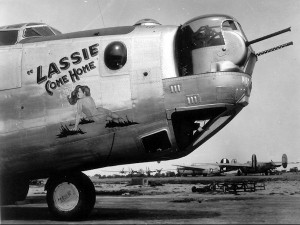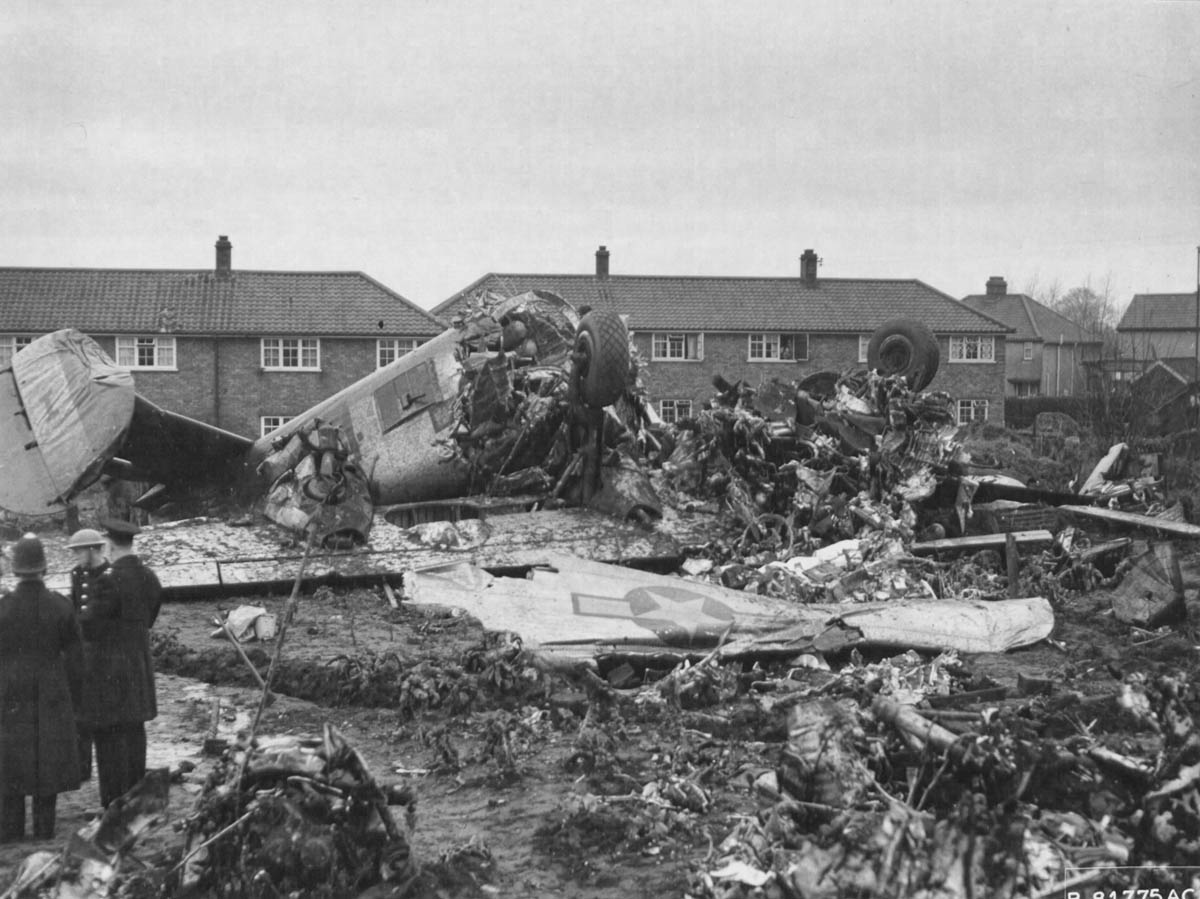Surprising what you find in your garden, I’ve found clay pipe stems and bowls and piece of Romano British pottery, meanwhile a friend of a friend found a bullet case just off Spynke Road in Norwich, it came from this Liberator, ‘Lassie Come Home’ she didn’t come home though. This is 1944, she crashed just behind the Boundary pub, just off the Cromer Road near Rye Avenue in Norwich. All but two of the crew died in the wreck, as did two children Mary and Brian Kemp who were playing in the garden when the bomber hit the ground Richard Kemp survived, and you can read more about his experience and more information about the incident here.
This one has all the makings of a great ghost, but might be awkward because of trees. Imagine that in your garden, probably very suddenly.
From here onwards the info is from elsewhere, sometimes it’s the best way to get a complete picture:
Stanley Diehl and crew arrived at Horsham in November 1944 and after a period of indoctrination began flying combat missions at the end of December. Their bombardier, Lt. Echdal was apparently removed from the crew prior to leaving the States, as his name is not on the records assigning them to the group.
On January 13, 1945, on what would have been the crew’s 5th mission, they were forced to abort due to co-pilot Harold Blanshan’s sinus trouble at altitude. It was for this reason that Blanshan did not fly on January 14th. 2Lt Leo Hecht, a newly arrived co-pilot on 2Lt Cecil G. Johnson’s crew took his place. It was Hecht’s first mission. The crew received battle damage over the continent, and with their #1 engine feathered, were attempting to land at Horsham when they lost a second engine on the same side. They crashed into a residential area about one mile south of the base. One crew member, Sgt Norton A. Lawson, the crew’s tail gunner, was the only survivor of the crash. After a period of recuperation, he went back to flying. While it is not known how many missions Lawson completed, he is shown flying with Lt Dean G. Williams crew on April 25th, the last mission of the war.
Crew
2Lt Stanley E Diehl 0718579 Pilot, KIA, Cambridge American Cemetery
2Lt Harold W Blanshan 02063963 Co-pilot 01-May-45 RFS Air Crew Leave
2Lt John J Clayborn 02065134 Navigator 14-Jan-45 KIA California
Sgt Rollin E Chapman 35224326 Radio Operator 14-Jan-45 KIA Cambridge American Cemetery
T/Sgt Walter R Denton 39320527 Flight Engineer 14-Jan-45 KIA Linn County, OR
Sgt Vincent P Hyland32261418 Nose Turret Gunner 14-Jan-45 KIA Cambridge American Cemetery
Sgt John D McNeely 38511715 Waist Gunner 14-Jan-45 KIA Chicot County, AR
Sgt Frederick G Wiehage 37619122 Top Turret Gunner 14-Jan-45 KIA St Louis, MO
S/Sgt Norton A Lawson 36828769 Tail Turret Gunner 15-May-45 FEH Reclassified 612
Letter from S/Sgt Henry Clayborn:
 In his search for more complete information on the death of his brother John (navigator), S/Sgt Henry F. Clayborn, U.S Army, on duty in France, obtained leave in March 1945 and made his way to Horsham St. Faith. He received a very warm welcome from the entire 753rd Squadron, especially the two remaining members of his brother’s crew, 2Lt Blanshan and Sgt Lawson. The following is an excerpt from a letter that he wrote to his sister-in-law, John’s widow Cleone:
In his search for more complete information on the death of his brother John (navigator), S/Sgt Henry F. Clayborn, U.S Army, on duty in France, obtained leave in March 1945 and made his way to Horsham St. Faith. He received a very warm welcome from the entire 753rd Squadron, especially the two remaining members of his brother’s crew, 2Lt Blanshan and Sgt Lawson. The following is an excerpt from a letter that he wrote to his sister-in-law, John’s widow Cleone:
“After I arrived in England and got myself set up for my stay I located Johnny’s group through the necessary channels and entrained for the closest city to his base. On the last leg of my journey I was fortunate enough to be traveling with one of the enlisted men from his squadron who took me directly to the squadron’s commanding officer. I don’t think that I have ever been treated better in any military installation than I was at the 753rd squadron. There was nothing that they didn’t offer to do for me and any request I made, no matter how tiny, was immediately granted….
“When I finally located the co-pilot, I was treated as if I were his own brother who had come to visit him. You see, the job of writing you the information I’m about to give was going to have to be done by him and I’m sure you realize how hard it would have been to write…. When Blansh heard that I was in the squadron orderly room he rushed up and insisted that I come with him to the combat officer’s quarters and stay with him. The pilot who was his room mate insisted that I use his bed and moved to a vacant one, in spite of any protests I could make. As it was close to supper time we decided to wait until after supper for our talk, at which time Lawson wound get over to Blansh’s room. It’s an army custom to use nicknames for your friends and if I tell you the nicknames of Lawson (Foggy) and Blanshan (Blansh) I can make it a little easier for myself. If Foggy and Blansh are any samples of the crew as a whole it really was a swell crew. From what I learned about each member in particular I would have been proud to have been one of them.
“As we did that night I am going to start my account of the flight itself. It was their “air medal” flight. When a crew completes its sixth mission over enemy territory it receives the air medal and this was the sixth mission. Foggy was the one from whom I got the story of the flight as he alone knew best everything that had happened. Until they were nearing the target everything went along as per routine. Then a flak burst damaged the number one engine on the left hand side seriously so that it was necessary to feather it. In addition the number two engine on that side started to smoke. Diehl was able to keep it going, however, and they were able to resume their position and make their bomb run. After they had unloaded their bombs, of course, they were unable to keep up with their regular formation and were forced to fall back. Eight fighter planes remained with them to provide protection from enemy fighters. The distance to England or Belgium at that time was equal and Diehl took an interphone vote among the crew members as to which spot they would head.
“Unanimously they voted to head for England. As they were now flying alone, as far as the bomber formation was concerned, the task of getting them there as fast as possible rested directly on Johnny. He was completely equal to the task. He gave them immediately an ETA (estimated time of arrival) of 3:28 PM at the Coast of England, and exactly at 3:28 they crossed the coast. His job had been done perfectly. Now everyone was relieved because the hardest part had been accomplished. They called the tower for priority landing and were granted the priority and completed the greater part of the circle on the field that is necessary for landing. As they were making the final turn it was necessary to bank into the left side (where the number one engine was feathered) and at the moment they were making the turn the number two engine cut out, leaving the left side completely dead. The force of the two right engines, of course, pushed the plane right over on its back and they crashed into a square of houses bordering the airport. Somehow, in that split second before the crash Diehl must have switched off the engines because there was no fire, although there was a lot of gas in all the tanks. Everyone in the plane was killed except Foggy and an extra gunner who had gone along.
“My greatest fear all along had been that Johnny’s death might have been painful or that perhaps his body had not been recovered. I know now that he died painlessly and that there was not a chance of his body not having been recovered. The reason I know is because Foggy came out of the plane alive and he had moved up near Johnny’s position just before the crash. It happened so fast that none of them except perhaps Diehl could have known what was happening. Foggy said that the only sensation that he could remember was a slight breathlessness like when an elevator goes down and then nothing. Earlier, the other gunner had told me the same thing
458th Bomb Group B-24 named “Lassie Come Home” (753rd BS, B-24J-155-CO, s/n 44-40283)
USAAF photo, Washington, out of copyright. Thanks to Brendan in Ipswich for winging it over and Moggy on the Aviation forum for the Clayborn letter (original published here)


Hi my nan lived at a house on Rye Road Joan Copeman she was a child and was at the corner shop when the plan came down the family thought she had died in the garde. Nan said at night she remembers looking out of her window and all she saw was a tight group of american military police standing round the site and their white helemts shone in the moon light they stayed their all night.
Hi Ian – Did your nan ever mention that the mother of the children killed in the garden later found the wedding ring belonging to the B-24 crew and she returned it to the airfield?
An elderly lady I knew named Evelyn was visiting her sister on a Sunday afternoon when Lassie Come Home crashed nearby on Spynke Road. She was knocked unconscious and came to while being helped. A doctor cleared her to go home, and told her to ‘get on with her life’. She was a teenager at the time. Evelyn emigrated to New Zealand where I met her. She said that she had visited a memorial to the dead of the crash, including the children who had been outside playing. A courageous lady, typical of her generation.
I believe I’ve commented before on a similar site… but my uncle who I was close to was the surviving member of the crew, Norton Lawson. Amazing stories he had and a reason I love the stories Air Force members who fought so bravely.